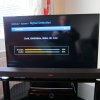-
 The forum software that supports hummy.tv has been upgraded to XenForo 2.3!
The forum software that supports hummy.tv has been upgraded to XenForo 2.3!
Please bear with us as we continue to tweak things, and feel free to post any questions, issues or suggestions in the upgrade thread.
You are using an out of date browser. It may not display this or other websites correctly.
You should upgrade or use an alternative browser.
You should upgrade or use an alternative browser.
HDR-fox-T2 poor signal strength
- Thread starter Tommy
- Start date
Ch 39 S72%, Q100% 20kW erp 64QAM
Ch 42 S60%, Q100% 20kW erp 64QAM
Ch 45 S51%, Q 100% 20kW erp 256QAM
Ch 33 S73%, Q 100% 10kW erp 64QAM
Ch 36 S75%, Q100% 10kW erp 64QAM
Ch 48 S44%, Q100% 10kW erp 64QAM
Ch 34 S55%, Q100% 1kW erp QPSK
From those readings I'd usually say that the aerial must be an old group A and has poorer and poorer reception at the higher frequencies above 39. Except that Angus was a group C/D analogue transmitter!
So it must be some form of problem with attenuation as frequency rises.
Very carp and lossy cable from the aerial?
Trees in leaf?
Or some weird reflections that is cancelling out the higher frequencies.
NB Is this with or without the 5G filter?
Any road it's probably time to replace that aerial with a group K and new WF100 to the amplifier.
Or even try a loft aerial that could be fitted externally later.
Ch 42 S60%, Q100% 20kW erp 64QAM
Ch 45 S51%, Q 100% 20kW erp 256QAM
Ch 33 S73%, Q 100% 10kW erp 64QAM
Ch 36 S75%, Q100% 10kW erp 64QAM
Ch 48 S44%, Q100% 10kW erp 64QAM
Ch 34 S55%, Q100% 1kW erp QPSK
From those readings I'd usually say that the aerial must be an old group A and has poorer and poorer reception at the higher frequencies above 39. Except that Angus was a group C/D analogue transmitter!
So it must be some form of problem with attenuation as frequency rises.
Very carp and lossy cable from the aerial?
Trees in leaf?
Or some weird reflections that is cancelling out the higher frequencies.
NB Is this with or without the 5G filter?
Any road it's probably time to replace that aerial with a group K and new WF100 to the amplifier.
Or even try a loft aerial that could be fitted externally later.
prpr
Well-Known Member
I'd had the same thought.I'd usually say that the aerial must be an old group A
Yeah, but how old is it? It's been bl@@dy wet everywhere this winter and you get even worse weather in Scotland. I wonder if it's not got water in and become all corroded. That's what happened to my last one. The high frequencies are first to go.The antenna is a solid installation using T & K brackets externally mounted.
Probably, but get a decent one this time, eh.Is this a job for an aerial man to check with his equipment?
So fitting the filter (should have) ruled out 5G / 4G interference. EDIT Therefore it's probably not needed.
But you now have 80% Q rather that 100% form the other day so more errors in the received signal for whatever reason. S at 48% staying the same.
I refer you back to my earlier post: Replace the aerial and/or cable as that is likely the cause of drooping output with increasing frequency.
Option 1: Replace aerial with a new Yagi 18K (perhaps from ATV aerials). Replacing the cable with WF100 or equivalent all copper spec.
Option 2: Replace just the cable.
Option 3: Get the Yagi 18K (or even AN Othter aerial) and fit it in the loft with some WF100 as an experiment. If it works fine leave it there or fit it outside to get a higher signal (circa 10x or 10dB probably).
The Yagi 18K is more robust than any X-beam. Do not buy those if you plan to fit it outside. https://www.aerialsandtv.com/knowledge/aerials/atvs-choice-of-tv-aerials-and-why-we-chose-them
NB I have no connection with ATV aerials.
Justin, the owner, gives the information on his website freely and deserves payback via people purchasing from him.
But you now have 80% Q rather that 100% form the other day so more errors in the received signal for whatever reason. S at 48% staying the same.
I refer you back to my earlier post: Replace the aerial and/or cable as that is likely the cause of drooping output with increasing frequency.
Option 1: Replace aerial with a new Yagi 18K (perhaps from ATV aerials). Replacing the cable with WF100 or equivalent all copper spec.
Option 2: Replace just the cable.
Option 3: Get the Yagi 18K (or even AN Othter aerial) and fit it in the loft with some WF100 as an experiment. If it works fine leave it there or fit it outside to get a higher signal (circa 10x or 10dB probably).
The Yagi 18K is more robust than any X-beam. Do not buy those if you plan to fit it outside. https://www.aerialsandtv.com/knowledge/aerials/atvs-choice-of-tv-aerials-and-why-we-chose-them
NB I have no connection with ATV aerials.
Justin, the owner, gives the information on his website freely and deserves payback via people purchasing from him.
Black Hole
May contain traces of nut
That's more like it though. I have been puzzling how a signal with (reportedly) 100% quality could result in defects at all, unless the problem is internal.But you now have 80% Q rather that 100% form the other day so more errors in the received signal for whatever reason
I have no absolute faith that Q of 100% on any humax = zero (uncorrectable?) errors.That's more like it though. I have been puzzling how a signal with (reportedly) 100% quality could result in defects at all, unless the problem is internal.
On Foxsat-HDR the Q can be less than 100 with no obvious artefacts seen.
OPs Sony was reporting received errors, but all were correctable, on a different outlet/cable.
So it is a bit of a mystery... without travelling to Dundee with all the right professional metering and spectrum analyser kit. Which I no longer have access to.
Black Hole
May contain traces of nut
Why?I have no absolute faith that Q of 100% on any humax = zero (uncorrectable?) errors.
Regardless, I see clean pictures when Q = 100% and glitches when Q is less, and I get 100% as long as the signal is 30% or more, sometimes less.
Why not?Why?
Your experience and mine can and probably will differ!
I also told you why... I dislike people who selective quote me in an attempt to make some sort of 'point-scoring'.
Black Hole
May contain traces of nut
Be as indignant as you like,
Where does a Q figure come from? Surely it's a product of the error correction system, and therefore 100% means the output from error correction is error-free.
...is a statement of credo rather than fact. You're making a claim without evidence. If calling out such blather is point scoring, I'll score away thank you.I have no absolute faith that Q of 100% on any humax = zero (uncorrectable?) errors.
Where does a Q figure come from? Surely it's a product of the error correction system, and therefore 100% means the output from error correction is error-free.
If you were the Humax design engineer you'd know. You are not and do not. Just masking assumptions.Be as indignant as you like,
...is a statement of credo rather than fact. You're making a claim without evidence. If calling out such blather is point scoring, I'll score away thank you.
Where does a Q figure come from? Surely it's a product of the error correction system, and therefore 100% means the output from error correction is error-free.
BH you are just acting as an AH again.
Owen Smith
Well-Known Member
Foxsat-HDR is a different product, it is quite unlike the HDR Fox T2 and especially in the RF reception handling (satellite vs terrestrial). I don't think anything can be read into Foxsat-HDR signal quality handling when talking about HDR Fox T2. These are all idiot meters with no absolute meaning, we don't even know if 100% quality means zero errors pre viterbi, post viterbi, or something else entirely.I have no absolute faith that Q of 100% on any humax = zero (uncorrectable?) errors.
On Foxsat-HDR the Q can be less than 100 with no obvious artefacts seen.
Black Hole
May contain traces of nut
If it were pre-viterbi (by which I take you mean error detected, correction required), I would expect there to be far more detections and much lower Q. It only makes sense if the Q output is a measure of uncorrectable errors, but I admit that is an educated guess and not specifications.we don't even know if 100% quality means zero errors pre viterbi, post viterbi, or something else entirely.



